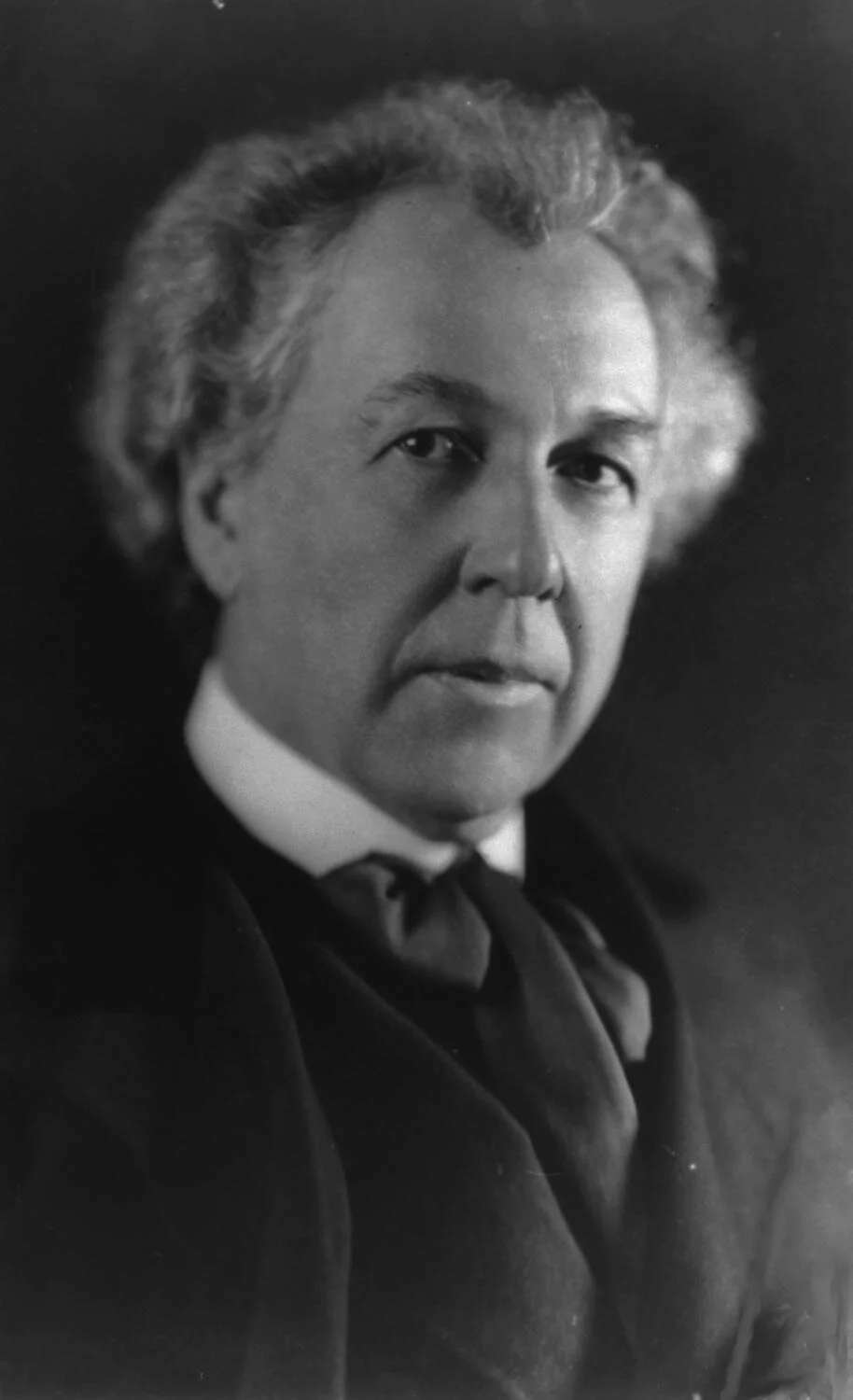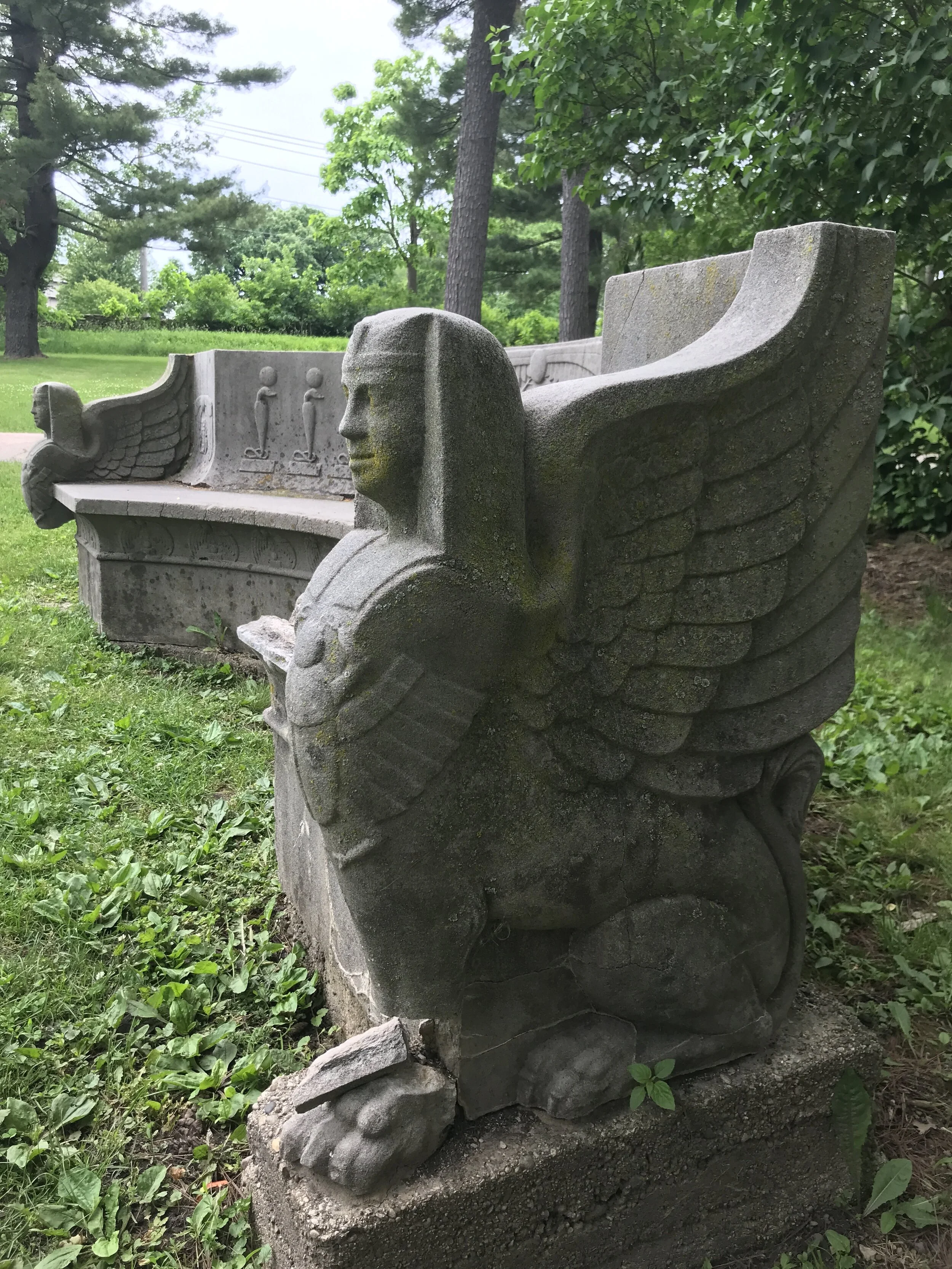Tour the picturesque Riverbank estate, with the Fabyan Forest Preserve, a Japanese garden, a windmill, quirky curios (a suspect mummy!) — and a codebreaking legacy.
The Fabyan Villa can thank Frank Lloyd Wright for its cruciform shape. The house and its grounds are worth exploring if you want to take a day trip from Chicago.
Before my parents make their annual visit to Wally and me in Chicago, we plan an interesting day trip, do a little research and look for something quirky to do. Typically it’s somewhere a bit farther afield since neither of us has a car. I can’t recall how we settled on the Fabyan Villa in Geneva, Illinois. It’s entirely possible that I came across it on the Atlas Obscura website, given Wally’s and my proclivity for attractions that don’t always make their way into guidebooks. Or it could've had something to do with Frank Lloyd Wright, the Japanese garden or the circa-1850 Dutch-style windmill located on the grounds of the sprawling estate.
Colonel George Fabyan
George Fabyan, Country Squire of Riverbank
In 1905, Colonel George and Nelle Fabyan purchased 10 acres of land in Geneva, including a Victorian-style farmhouse, as a country retreat from their residence in Chicago. Fabyan (pronouced like Fay-bee-yen) came from a wealthy and prominent Boston family. His father was a co-partner at Bliss, Fabyan and Company, one of the country’s largest dry goods and textile merchants, known for Ripplette, a lightweight, crinkly fabric similar to seersucker, which needed no to minimal ironing after washing.
Fabyan inherited his father’s wealth — around $2 million dollars (equivalent to over $57 million today). He acquired an additional 300-plus acres over the next 20 years and named the estate Riverbank.
George and Nelle indulged in a variety of unconventional interests, including cryptology, Japanese gardening and the construction of a scientific laboratory complex that let them pursue their research interests.
“Some rich men go in for art collections, gay times on the Riviera or extravagant living. But they all get satiated.
That’s why I stick to scientific experiments, spending money to discover valuable things that universities can’t afford. You can never get sick of too much knowledge.”
The Fabyan Villa Museum
A Tour of Fabyan Villa
The four of us arrived at the forest preserve, parked the car and followed the steps leading up to the house, which sits on a hillside overlooking the Fox River. We purchased tickets ($10 per person) and met a docent from the Preservation Partners of Fox Valley (PPFV) outside who told us about the historic home. In 1907, the Fabyans commissioned architect Frank Lloyd Wright to enlarge and remodel the existing farmhouse in the Prairie style. While it’s no Fallingwater or even Graycliff, it has its charms.
Additions included the two-story south wing, which added symmetry to the dwelling’s long, low cruciform shape, three projecting porches, wood-spindle screening and overhanging eaves, adding to the horizontality of the overall design.
Our tour began in the Fabyans’ reception room, which is paneled in dark walnut and furnished with Victorian-era wood and glass display cabinets, showcasing the couple’s memorabilia, taxidermy and Asian ephemera. Among the notable acquisitions on display are a white marble statue of Diana and the Lion (Intellect Dominating Force) by American sculptor Frank Edwin Elwell, which stands in the dining room and was originally exhibited in the Palace of Fine Arts at the 1893 World’s Columbian Exposition. There’s also a Japanese samurai suit and a vitrine filled with bodhisattva statuettes.
On the back porch is a display case holding a mummy. Its body is wrapped in strips of linen and clutching what uncannily resembles an infant. Turns out the mummy is actually a forgery. In 1982, an expert examined the mummy, and an X-ray revealed it to be fabricated with nails, plywood, sawdust and a single bone inside the wrappings — and that bone came from a dog. Apparently, no one’s certain of its provenance or if the original owners knew it was a fake. One theory is that it may have been featured as a sideshow oddity or was an artifact purchased by Fabyan from the Field Museum.
The Fabyans’ mummy turned out to be a hoax.
Beyond the dining room is Nelle Fabyan’s bedroom and en suite bathroom with custom furniture designed by Wright. Nelle had a hanging bed, suspended from the ceiling like a giant swing, and it’s speculated that this was to promote air circulation and protect her from contracting tuberculosis. Many of the original furnishings were auctioned off when the estate was sold in 1939, but locals who owned pieces donated them back to the landmark, which is managed by the PPFV.
Frank Lloyd Wright didn’t build the Fabyan Villa from scratch — but he did renovate it, infusing it with Prairie style aesthetics and symmetry.
Wright’s Prairie style aesthetic is also evident in the open floor plan and warm earth tone color palette used on the walls of the interior.
Upstairs is the music room, where Nelle’s Victor Talking Machine aka Victrola, encased in a wood cabinet, stands sentinel. Only the wealthy could afford the innovative Victor-Victrola model, whose initial selling price was $200, expensive for the time.
Duke and Wally explore the estate.
Duke and his parents in the rose arbor (which was noticeably lacking roses at the time of our visit).
Connected to the music room is the sleeping porch, where the pet monkeys, Mike, Patsy and Molly, would stay during the winter months. The floor of the room is tinplate, with drainage incorporated for obvious reasons (monkey waste). Perhaps the simians filled the vacant role of children to the childless couple?
Furniture, art and light were an integral part of Wright’s conceptual philosophy, creating compositions that functioned as a cohesive whole. As such, he would have most likely despised the ornate Victorian bed in the second floor bedroom. Wright’s leaded glass cathedral-style windows or “light screens” as the architect called them, fill the room with light. They’re not the intricate geometric stained glass affairs he was famous for elsewhere, as, out here in the countryside, he didn’t want to obscure the beauty of the natural view.
The house’s grounds lead down to the Fox River.
Fabyan’s Animal Kingdom
In addition to that trio of monkeys, a menagerie of animals lived on the estate, including Cayman alligators, a pair of black bears (named Tom and Jerry after a popular Midwestern milk punch served at the holidays), cows and dogs. A bear cage remains southwest of the garden, and according to local lore, loaves of bread were baked in the basement of the windmill to feed Fabyan’s pet bears.
Japanese gardens were a craze with the elite in the early 1900s, and the Fabyans added a lovely one to Riverbank.
Turning Japanese: The Fabyan Japanese Garden
Awaiting visitors outside and just beyond the villa are the Japanese gardens and rose arbor, which lead from the bottom of the slope at the rear of the villa down to the banks of the Fox River. After the Japanese embassy created a garden for the 1893 World’s Fair, they became a status symbol among the wealthy.
The Fabyans’ gardens were built between 1910 and 1913 by landscape architect Issei Taro Otsuka, a Japanese immigrant gardener who later redesigned the 1893 Wooded Island in Jackson Park for the Century of Progress International Exposition, the second world’s fair hosted by Chicago.
The gardens were closed on our visit, but we were able to see the torii gate, traditionally found at the entrance of a Shinto shrine and demarcating the passage from the earthly to the sacred. The gardens looked beautiful from afar, with conifer pine trees, traditional stone lanterns and a graceful curved bridge reflected in the pond beneath it.
Although Fabyan didn’t serve in the armed services, he was given the honorary title of colonel by Illinois Governor Richard Yates out of gratitude for his public service work after Fabyan allowed the National Guard to use the estate as a training ground — and from that time on, George was known as Colonel Fabyan. He also received Japan’s Order of the Rising Sun, a decoration of honor awarded for his invaluable participation in peace negotiations with Japanese emissaries, a few of whom stayed on the property when the Colonel and Nelle hosted them.
Riverbank Laboratories, owned by Fabyan, conducted acoustic research and later became instrumental in codebreaking.
Codebreaking at Riverbank Laboratories: Birth of the NSA
The Fabyan estate also carried on extensive scientific research, with greenhouses where they would grow exotic plants and conduct genetic experiments. Across the street from the villa is Riverbank Laboratories. This was Fabyan’s think tank. He was interested in subjects as diverse as acoustics and, perhaps the Colonel`s most famous legacy, the cryptology laboratory.
The acoustics laboratory, which is still in operation today, was built around an ultra-quiet test chamber for the study of soundwaves and was designed by the top acoustics expert in the country, Professor Wallace Sabine of Harvard University.
One of the Colonel’s odder obsessions was a belief that Sir Francis Bacon was the true author of some (or even all) of Shakespeare’s literary works, and that Bacon had left coded messages within the plays and sonnets. Fabyan hired Elizabeth Wells Gallup, a scholar and author of The Bi-literal Cypher of Sir Francis Bacon, to decipher a binary alphabet to reveal secret messages in the works of Shakespeare.
Fabyan was convinced that there were clues in Shakespeare’s plays that revealed that their true author was actually Sir Francis Bacon.
Gallup’s team included Elizebeth and William Friedman, who spent years honing their cryptology skills researching the Bard’s works using Bacon’s ciphers. Though largely inconclusive, their efforts weren’t entirely in vain: The couple was instrumental in breaking codes and ciphers during World War I and World War II. Because the U.S. military didn’t yet have a dedicated department devoted to codebreaking, Fabyan’s Riverbank Laboratories ended up being the foundation for the NSA, the National Security Agency.
Fabyan was quite proud of his windmill. Make sure you cross the Fox River and check it out.
Over the River to the Windmill
In 1914, Fabyan purchased a Dutch-style windmill for $8,000 from Yorktown, Illinois, about 20 miles from its current location, and spent around $75,000 reconstructing it on the east bank of the Fox River. The windmill stands at an impressive 68 feet high and was originally built by Louis Blackhaus, a German immigrant and craftsman, between 1850 and 1860.
But it was mainly a toy for Fabyan, who enjoyed showing it off to his Chicago friends. In 1979, the windmill was listed on the National Register of Historic Places, and the following year, it was selected to be on a U.S. postage stamp as part of a series in a booklet called Windmills USA.
Look for the fun Egyptianate benches on the lawn.
Preserving the Legacy of the Fabyan Villa and Forest Preserve
George died in 1936 and Nelle in 1939, and because they had no offspring, the Forest Preserve District of Kane County purchased the majority of the estate and opened the residence as a museum the following year. Starting in 1995, the nonprofit PPFV was enlisted to maintain and provide tours of the historic dwelling. The house was added to the National Registerof Historic Places in 1984.
The four of us had a wonderful time wandering the paths that cross the bucolic park-like setting of the historic estate, with plenty of photo opportunities along the way. It’s an easy drive (just over 40 minutes from Chicago) and it’s remarkable to consider the lasting scientific achievements that germinated from the Fabyans’ private research center. If you’re looking for a fun place to visit that combines architecture and nature, the Fabyan Villa is open for tours from May to October. –Duke
Fabyan Villa Museum & Japanese Garden
Fabyan Forest Preserve
1925 South Batavia Avenue
Geneva, Illinois, USA

































